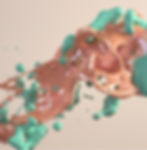"Our life is shaped by our mind, for we become what we think." -Buddha

"Mindfulness" has become a trendy topic lately with plenty of self-help gurus and psychotherapists encouraging us to be more mindful in our actions, and practice special exercises to achieve "mindfulness". Psychology Today defines mindfulness in 3 ways:
1.) Mindfulness is letting go of taking things for granted.
2.) Mindfulness means to return to the present moment.
3.) Mindfulness is the self-regulation of attention with an attitude of curiosity, openness, and acceptance.
To the first point, mindfulness is not just letting go of"taking things for granted", it's letting go of all judgment and attachment- right, wrong, good or bad; and this helps lead into the second and third definitions. And it's also accepting any passing judgments you make, before you let them pass as well. It's a fluid state that keeps you grounded in the present moment.
Can kids practice mindfulness? Most definitely!
What about children with special needs? Absolutely!
In fact, sensory processing challenges require you to tap into common ideas and insights used in mindfulness training. Your sensory system occurs here in the present moment; you probably cannot hear words spoken yesterday, you most likely aren't able to smell what dinner will be like tonight. In order to learn to regulate your sensory system, you need to be fully present in the moment and ready to take in what's around you- without judgment.
Of course, explaining this to a child would be challenging! This is where we learn through modeling and guidance. I'm a big fan of messy play! Ask anyone who has worked with me, I encourage breaking out the slime, play dough, finger paints, soft and stretchy fabrics, loud instruments and big movements. This takes a special patience for us as adults. We were told from a young age to keep clean, don't make a mess, and if you do, you better clean it up quick!
Let this go and allow yourself to be in the moment with messy play. Of course, put down a plastic tarp or whatever precautions will make you comfortable with making a mess. After these steps, get ready to get up to your elbows in it! Giggle and talk about how cold the paint feels; how it slides between your fingers and over the backs of your hands. Watch how the colors spiral and mix together; stay focused in the moment. Let all your thoughts fall aside. Most importantly, stay in the moment.
Mindfulness requires a state of acute focus on the present. Cast your anxieties, hopes and expectations to the side; live in this moment. Often mindfulness practices encourage you to focus on your breath using counting or simple "in, out" phrases. I'm encouraging you to utilize a different sensory experience- tactile. Just as you would focus on your breath, focus on that blue paint oozing between the crevices of your fingers. Does this make you squirm? Does this tickle? Acknowledge how it's making you feel and then watch your child to see how they're reacting. If it's making you uncomfortable, say, "Wow, this sure is slimy! I'm not so sure if I like it." Keep your words light, but acknowledge your discomfort. It's okay to be uncomfortable and it's important we model both comfortable and uncomfortable feelings for our children.
Cleaning up is usually why we don't like getting dirty. We dread the wipe down and sweep up. However, this is an opportunity to discuss the activity with your children. What did they like? What didn't they like? This is also an opportunity to model daily routine language as you self-talk your way through each chore. Self-talk is another excellent way to teach and expand language; but it's also a mindfulness practice! Again, focusing your mind to the present. When you make messy play and the consequent clean up language-rich and present-focused activities, you'll be surprised how much more enjoyable they truly are.
How are you getting dirty today? Let me know!